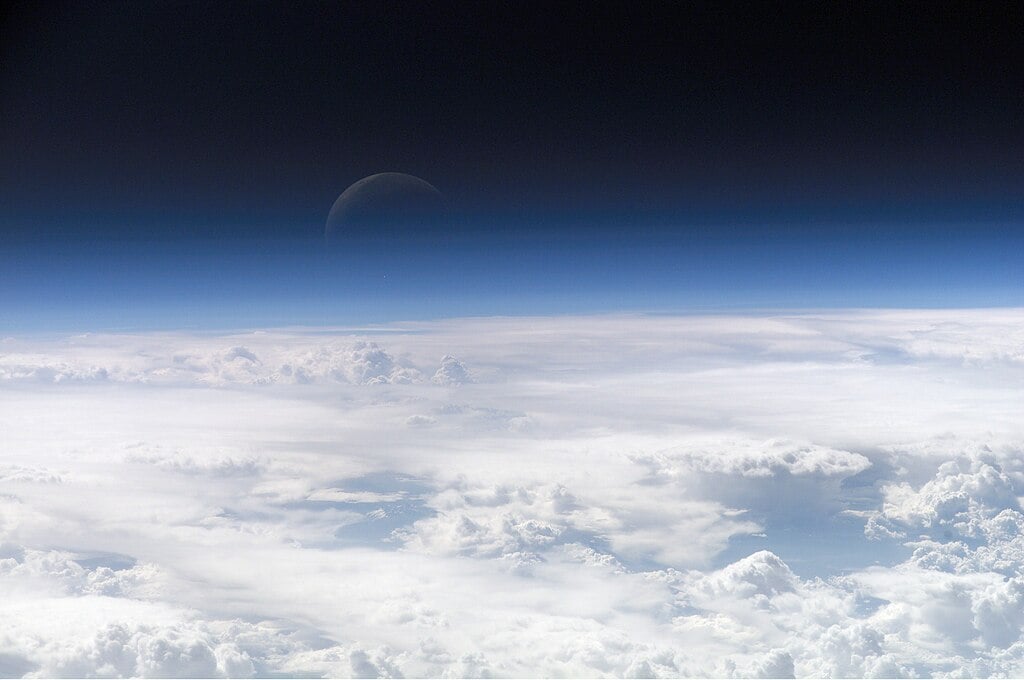Low Earth orbit might seem like empty space, but for the thousands of satellites circling our planet between 95 and 1,900 km up, it's actually a surprisingly hostile environment. Every moment, these spacecraft are bombarded by highly reactive oxygen atoms that corrode their surfaces, while collisions with atmospheric molecules create drag that gradually pulls them back toward Earth. Most satellites last only about five years before these relentless forces take their toll, and the spacecraft tumbles back through the atmosphere. Now, a team at the University of Texas in Dallas is developing a protective coating that could fundamentally change how long satellites survive in orbit.
 Earth's atmosphere from space, showing a blue layer at the stratosphere. It's a hostile environment for any satellite launched into low Earth orbit (Credit : NASA)
Earth's atmosphere from space, showing a blue layer at the stratosphere. It's a hostile environment for any satellite launched into low Earth orbit (Credit : NASA)
The primary culprit damaging spacecraft in low Earth orbit is atomic oxygen. When ultraviolet radiation from the Sun strikes molecular oxygen in the thin upper atmosphere, it splits the molecules apart into individual atoms. These single atoms are far more reactive than the stable O₂ molecules we breathe, and they're the most common particles satellites encounter in low Earth orbit. When these atoms collide with spacecraft surfaces, they don't just bounce off, they bind to the material, causing oxidation. Essentially, satellites are slowly rusting in space.
Beyond the corrosion problem, satellites also face the challenge of drag. Each collision with particles in the atmosphere, whether oxygen atoms or other molecules, slows the satellite down ever so slightly. Over time, these countless tiny impacts cause the spacecraft to lose altitude and eventually fall back to Earth. It's a double threat that engineers have been struggling to address: materials need to resist both chemical erosion and the physical forces of atmospheric drag.
The team, led by materials scientist Rafik Addou, is tackling this challenge by borrowing techniques from other industries and applying them in novel ways. One approach uses atomic layer deposition, a method originally developed for manufacturing microelectronics. This process builds up protective coatings one atomic layer at a time, offering unprecedented control over the material's structure and properties. The precision matters enormously when you're trying to create a surface that can withstand the unique conditions of space.
 Schematic illustration of one reaction cycle of the ALD process, using the trimethylaluminium (TMA) -water process to make thin aluminium oxide films as (simplified) example (Credit : By Véronique Cremers, Riikka Puurunen, Jolien Dendooven)
Schematic illustration of one reaction cycle of the ALD process, using the trimethylaluminium (TMA) -water process to make thin aluminium oxide films as (simplified) example (Credit : By Véronique Cremers, Riikka Puurunen, Jolien Dendooven)
Their second technique, called sol-gel processing, creates solid materials from liquid solutions. This method, commonly used to make optical coatings like the anti-reflective layers on eyeglasses, allows researchers to engineer surfaces smooth enough to minimise atmospheric drag while maintaining protective properties. By combining these approaches, the team has developed a coating that, according to independent testing, can withstand atomic oxygen conditions even more extreme than those actually found in space.
Addou and his colleagues hope their work will enable spacecraft to operate in very low Earth orbit, where the environment is significantly harsher due to higher concentrations of atomic oxygen and nitrogen. This region offers advantages for certain applications but has been largely unusable because materials degrade so rapidly there. If successful, their protective coatings could open up new possibilities for satellite operations in this challenging but potentially valuable orbital zone.
Source : Engineers developing new protective coating for spacecraft
.png)




